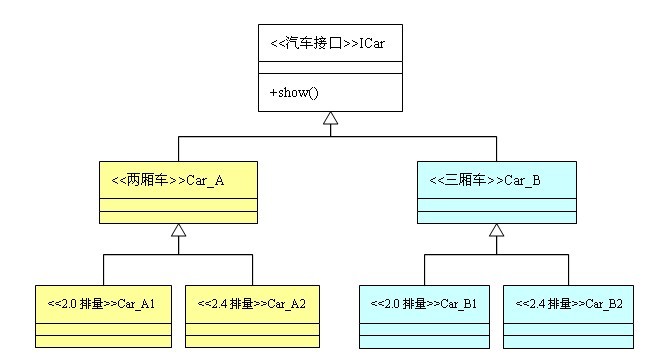ҫcХdһӢеQ?/strong>еҲӣеҫҸҫcАLЁЎеј?/p> ҫcХdӣҫеQ?/strong> жҠҪиұЎе·ҘеҺӮжЁЎејҸдёҺе·ҘеҺӮж–№жі•жЁЎејҸзҡ„еҢәеҲ« жҠҪиұЎе·ҘеҺӮжЁЎејҸжҳҜе·ҘеҺӮж–№жі•жЁЎејҸзҡ„еҚҮзс”зүҲжң¬еQҢд»–з”ЁжқҘеҲӣеҫҸдёҖҫl„зӣёе…ПxҲ–иҖ…зӣёдә’дҫқиө–зҡ„еҜ№иұЎгҖӮд»–дёҺе·ҘеҺӮж–№жі•жЁЎејҸзҡ„еҢәеҲ«һ®ұеңЁдәҺпјҢе·ҘеҺӮж–ТҺі•жЁЎејҸй’ҲеҜ№зҡ„жҳҜдёҖдёӘдс”е“ҒзӯүҫU§з»“жһ„пјӣиҖҢжҠҪиұЎе·ҘеҺӮжЁЎејҸеҲҷжҳҜй’ҲеҜ№зҡ„еӨҡдёӘдә§е“ҒҪ{үзс”ҫl“жһ„гҖӮеңЁҫ~–зЁӢдёӯпјҢйҖҡеёёдёҖдёӘдс”е“Ғз»“жһ„пјҢиЎЁзҺ°дёЮZёҖдёӘжҺҘеҸЈжҲ–иҖ…жҠҪиұЎзұ»еQҢд№ҹһ®ұжҳҜиҜЯ_јҢе·ҘеҺӮж–ТҺі•жЁЎејҸжҸҗдҫӣзҡ„жүҖжңүдс”е“ҒйғҪжҳҜиЎҚз”ҹиҮӘеҗҢдёҖдёӘжҺҘеҸЈжҲ–жҠҪиұЎҫc»пјҢиҖҢжҠҪиұЎе·ҘеҺӮжЁЎејҸжүҖжҸҗдҫӣзҡ„дс”е“ҒеҲҷжҳҜиЎҚз”ҹиҮӘдёҚеҗҢзҡ„жҺҘеҸЈжҲ–жҠҪиұЎҫc…RҖ?/p> еңЁжҠҪиұЎе·ҘеҺӮжЁЎејҸдёӯеQҢжңүдёҖдё?strong>дә§е“Ғж—?/strong>зҡ„жҰӮеҝөпјҡжүҖи°“зҡ„дә§е“Ғж—ҸпјҢжҳҜжҢҮдҪҚдәҺдёҚеҗҢдә§е“ҒҪ{үзс”ҫl“жһ„дёӯеҠҹиғҪзӣёе…ҢҷҒ”зҡ„дс”е“Ғз»„жҲҗзҡ„家ж—ҸгҖӮжҠҪиұЎе·ҘеҺӮжЁЎејҸжүҖжҸҗдҫӣзҡ„дёҖҫpХdҲ—дә§е“Ғһ®Юq»„жҲҗдёҖдёӘдс”е“Ғж—ҸеQӣиҖҢе·ҘеҺӮж–№жі•жҸҗдҫӣзҡ„дёҖҫpХdҲ—дә§е“ҒҝUоCШ“дёҖдёӘзӯүҫU§з»“жһ„гҖӮжҲ‘们дҫқ然жӢҝз”ҹдс”жұҪиһRзҡ„дҫӢеӯҗжқҘиҜҙжҳҺ他们д№Ӣй—ҙзҡ„еҢәеҲ«гҖ?/p> еңЁдёҠйқўзҡ„ҫcХdӣҫдёӯпјҢдёӨеҺўиҪҰе’ҢдёүеҺўиҪҰз§°дёЮZёӨдёӘдёҚеҗҢзҡ„Ҫ{үзс”ҫl“жһ„еQӣиҖ?.0жҺ’йҮҸиҪҰе’Ң2.4жҺ’йҮҸиҪҰеҲҷҝUоCШ“дёӨдёӘдёҚеҗҢзҡ„дс”е“Ғж—ҸгҖӮеҶҚе…·дҪ“дёҖзӮ№пјҢ2.0жҺ’йҮҸдёӨеҺўиҪҰе’Ң2.4жҺ’йҮҸдёӨеҺўиҪҰеұһдәҺеҗҢдёҖдёӘзӯүҫU§з»“жһ„пјҢ2.0жҺ’йҮҸдёүеҺўиҪҰе’Ң2.4жҺ’йҮҸдёүеҺўиҪҰеұһдәҺеҸҰдёҖдёӘзӯүҫU§з»“жһ„пјӣиҖ?.0жҺ’йҮҸдёӨеҺўиҪҰе’Ң2.0жҺ’йҮҸдёүеҺўиҪҰеұһдәҺеҗҢдёҖдёӘдс”е“Ғж—ҸеQ?.4жҺ’йҮҸдёӨеҺўиҪҰе’Ң2.4жҺ’йҮҸдёүеҺўиҪҰеұһдәҺеҸҰдёҖдёӘдс”е“Ғж—ҸгҖ?/p> жҳҺзҷҪдәҶзӯүҫU§з»“жһ„е’Ңдә§е“Ғж—Ҹзҡ„жҰӮеҝөеQҢе°ұзҗҶи§Је·ҘеҺӮж–ТҺі•жЁЎејҸе’ҢжҠҪиұЎе·ҘеҺӮжЁЎејҸзҡ„еҢәеҲ«дәҶпјҢеҰӮжһңе·ҘеҺӮзҡ„дс”е“Ғе…ЁйғЁеұһдәҺеҗҢдёҖдёӘзӯүҫU§з»“жһ„пјҢеҲҷеұһдәҺе·ҘеҺӮж–№жі•жЁЎејҸпјӣеҰӮжһңе·ҘеҺӮзҡ„дс”е“ҒжқҘиҮӘеӨҡдёӘзӯүҫU§з»“жһ„пјҢеҲҷеұһдәҺжҠҪиұЎе·ҘеҺӮжЁЎејҸгҖӮеңЁжң¬дҫӢдёӯпјҢеҰӮжһңдёҖдёӘе·ҘеҺӮжЁЎејҸжҸҗдҫ?.0жҺ’йҮҸдёӨеҺўиҪҰе’Ң2.4жҺ’йҮҸдёӨеҺўиҪҰпјҢйӮЈд№Ҳд»–еұһдәҺе·ҘеҺӮж–№жі•жЁЎејҸпјӣеҰӮжһңдёҖдёӘе·ҘеҺӮжЁЎејҸжҳҜжҸҗдҫӣ2.4жҺ’йҮҸдёӨеҺўиҪҰе’Ң2.4жҺ’йҮҸдёүеҺўиҪҰдёӨдёӘдс”е“ҒпјҢйӮЈд№ҲҳqҷдёӘе·ҘеҺӮжЁЎејҸһ®ұжҳҜжҠҪиұЎе·ҘеҺӮжЁЎејҸеQҢеӣ дёЮZ»–жҸҗдҫӣзҡ„дс”е“ҒжҳҜеҲҶеұһдёӨдёӘдёҚеҗҢзҡ„зӯүҫU§з»“жһ„гҖӮеҪ“з„УһјҢеҰӮжһңдёҖдёӘе·ҘеҺӮжҸҗдҫӣе…ЁйғЁеӣӣҝUҚиһRеһӢзҡ„дә§е“ҒеQҢеӣ дёЮZс”е“ҒеҲҶеұһдёӨдёӘзӯүҫU§з»“жһ„пјҢд»–еҪ“然д№ҹеұһдәҺжҠҪиұЎе·ҘеҺӮжЁЎејҸдәҶгҖ?/p> жҠҪиұЎе·ҘеҺӮжЁЎејҸд»Јз Ғ жҠҪиұЎе·ҘеҺӮжЁЎејҸзҡ„дјҳзӮ?/strong> жҠҪиұЎе·ҘеҺӮжЁЎејҸйҷӨдәҶе…дhңүе·ҘеҺӮж–ТҺі•жЁЎејҸзҡ„дјҳзӮ№еӨ–еQҢжңҖдё»иҰҒзҡ„дјҳзӮ№е°ұжҳҜеҸҜд»ҘеңЁҫcИқҡ„еҶ…йғЁеҜ№дс”е“Ғж—ҸҳqӣиЎҢҫUҰжқҹгҖӮжүҖи°“зҡ„дә§е“Ғж—ҸпјҢдёҖиҲ¬жҲ–еӨҡжҲ–һ®‘зҡ„йғҪеӯҳеңЁдёҖе®ҡзҡ„е…ҢҷҒ”еQҢжҠҪиұЎе·ҘеҺӮжЁЎејҸе°ұеҸҜд»ҘеңЁзұ»еҶ…йғЁеҜ№дс”е“Ғж—Ҹзҡ„е…іиҒ”е…іҫp»иҝӣиЎҢе®ҡд№үе’ҢжҸҸиҝ°еQҢиҖҢдёҚеҝ…дё“й—Ёеј•е…ҘдёҖдёӘж–°зҡ„зұ»жқҘиҝӣиЎҢз®ЎзҗҶгҖ?/p> жҠҪиұЎе·ҘеҺӮжЁЎејҸзҡ„зјәзӮ?/strong> дә§е“Ғж—Ҹзҡ„жү©еұ•һ®ҶжҳҜдёҖ件еҚҒеҲҶиҙ№еҠӣзҡ„дәӢжғ…еQҢеҒҮеҰӮдс”е“Ғж—ҸдёӯйңҖиҰҒеўһеҠ дёҖдёӘж–°зҡ„дс”е“ҒпјҢеҲҷеҮ д№ҺжүҖжңүзҡ„е·ҘеҺӮҫc»йғҪйңҖиҰҒиҝӣиЎҢдҝ®ж”ҸVҖӮжүҖд»ҘдӢЙз”ЁжҠҪиұЎе·ҘеҺӮжЁЎејҸж—¶еQҢеҜ№дә§е“ҒҪ{үзс”ҫl“жһ„зҡ„еҲ’еҲҶжҳҜйқһеёёйҮҚиҰҒзҡ„гҖ?/p> йҖӮз”ЁеңәжҷҜ еҪ“йңҖиҰҒеҲӣе»әзҡ„еҜ№иұЎжҳҜдёҖҫpХdҲ—зӣжҖә’е…ҢҷҒ”жҲ–зӣёдә’дҫқиө–зҡ„дә§е“Ғж—Ҹж—¶еQҢдҫҝеҸҜд»ҘдҪҝз”ЁжҠҪиұЎе·ҘеҺӮжЁЎејҸгҖӮиҜҙзҡ„жӣҙжҳҺзҷҪдёҖзӮ№пјҢһ®ұжҳҜдёҖдёӘз‘фжүҝдҪ“ҫpЦMёӯеQҢеҰӮжһңеӯҳеңЁзқҖеӨҡдёӘҪ{үзс”ҫl“жһ„еQҲеҚіеӯҳеңЁзқҖеӨҡдёӘжҠҪиұЎҫc»пјүеQҢеЖҲдё”еҲҶеұһеҗ„дёӘзӯүҫU§з»“жһ„дёӯзҡ„е®һзҺ°зұ»д№Ӣй—ҙеӯҳеңЁзқҖдёҖе®ҡзҡ„е…ҢҷҒ”жҲ–иҖ…зәҰжқҹпјҢһ®ұеҸҜд»ҘдӢЙз”ЁжҠҪиұЎе·ҘеҺӮжЁЎејҸгҖӮеҒҮеҰӮеҗ„дёӘзӯүҫU§з»“жһ„дёӯзҡ„е®һзҺ°зұ»д№Ӣй—ҙдёҚеӯҳеңЁе…іиҒ”жҲ–ҫUҰжқҹеQҢеҲҷдҪҝз”ЁеӨҡдёӘзӢ¬з«Ӣзҡ„е·ҘеҺӮжқҘеҜ№дс”е“ҒиҝӣиЎҢеҲӣе»әпјҢеҲҷжӣҙеҗҲйҖӮдёҖзӮҸVҖ?/p> жҖИқ»“ ж— и®әжҳҜз®ҖеҚ•е·ҘеҺӮжЁЎејҸпјҢе·ҘеҺӮж–ТҺі•жЁЎејҸеQҢиҝҳжҳҜжҠҪиұЎе·ҘеҺӮжЁЎејҸпјҢ他们йғҪеұһдәҺе·ҘеҺӮжЁЎејҸпјҢеңЁеЕһејҸе’Ңзү№зӮ№дёҠд№ҹжҳҜжһҒдёәзӣёдјјзҡ„еQҢ他们зҡ„жңҖҫlҲзӣ®зҡ„йғҪжҳҜдШ“дәҶи§ЈиҖҰгҖӮеңЁдҪҝз”Ёж—УһјҢжҲ‘们дёҚеҝ…еҺХdңЁж„ҸиҝҷдёӘжЁЎејҸеҲ°еә•е·ҘеҺӮж–№жі•жЁЎејҸиҝҳжҳҜжҠҪиұЎе·ҘеҺӮжЁЎејҸпјҢеӣ дؓ他们д№Ӣй—ҙзҡ„жј”еҸҳеёёеёёжҳҜд»ӨдқhзҗўзЈЁдёҚйҖҸзҡ„гҖӮз»ҸеёжҖҪ дјҡеҸ‘зҺҺНјҢжҳҺжҳҺдҪҝз”Ёзҡ„е·ҘеҺӮж–№жі•жЁЎејҸпјҢеҪ“ж–°йңҖжұӮжқҘдёЯ_јҢҪEҚеҠ дҝ®ж”№еQҢеҠ е…ҘдәҶдёҖдёӘж–°ж–ТҺі•еҗҺпјҢз”ЧғәҺҫcЦMёӯзҡ„дс”е“Ғжһ„жҲҗдәҶдёҚеҗҢҪ{үзс”ҫl“жһ„дёӯзҡ„дә§е“Ғж—ҸпјҢе®ғе°ұеҸҳжҲҗжҠҪиұЎе·ҘеҺӮжЁЎејҸдәҶпјӣиҖҢеҜ№дәҺжҠҪиұЎе·ҘеҺӮжЁЎејҸпјҢеҪ“еҮҸһ®‘дёҖдёӘж–№жі•дӢЙзҡ„жҸҗдҫӣзҡ„дә§е“ҒдёҚеҶҚжһ„жҲҗдә§е“Ғж—Ҹд№ӢеҗҺпјҢе®ғе°ұжј”еҸҳжҲҗдәҶе·ҘеҺӮж–ТҺі•жЁЎејҸгҖ?/p> жүҖд»ҘпјҢеңЁдӢЙз”Ёе·ҘеҺӮжЁЎејҸж—¶еQҢеҸӘйңҖиҰҒе…іеҝғйҷҚдҪҺиҖҰеҗҲеәҰзҡ„зӣ®зҡ„жҳҜеҗҰиҫ‘ЦҲ°дәҶгҖ?/p>

ҪҺҖеҚ•е·ҘеҺӮжЁЎејҸжңүдёҖдёӘй—®йўҳе°ұжҳҜпјҢҫcИқҡ„еҲӣеҫҸдҫқиө–е·ҘеҺӮҫc»пјҢд№ҹе°ұжҳҜиҜҙеQҢеҰӮжһңжғіиҰҒжӢ“еұ•зЁӢеәҸпјҢеҝ…йЎ»еҜ№е·ҘеҺӮзұ»ҳqӣиЎҢдҝ®ж”№еQҢиҝҷҳqқиғҢдәҶй—ӯеҢ…еҺҹеҲҷпјҢжүҖд»ҘпјҢд»Һи®ҫи®Ўи§’еәҰиҖғиҷ‘еQҢжңүдёҖе®ҡзҡ„й—®йўҳеQҢеҰӮдҪ•и§ЈеҶ»Iјҹһ®Юq”ЁеҲ°е·ҘеҺӮж–№жі•жЁЎејҸпјҢеҲӣеҫҸдёҖдёӘе·ҘеҺӮжҺҘеҸЈе’ҢеҲӣеҫҸеӨҡдёӘе·ҘеҺӮе®һзҺ°ҫc»пјҢҳqҷж ·дёҖж—ҰйңҖиҰҒеўһеҠ ж–°зҡ„еҠҹиғҪпјҢзӣҙжҺҘеўһеҠ ж–°зҡ„е·ҘеҺӮҫcХd°ұеҸҜд»ҘдәҶпјҢдёҚйңҖиҰҒдҝ®ж”№д№ӢеүҚзҡ„д»Јз ҒгҖ?/p>

иҜпLңӢдҫӢеӯҗеQ?/p>
- public interface Sender {
- public void Send();
- }
дёӨдёӘе®һзҺ°ҫc»пјҡ
- public class MailSender implements Sender {
- @Override
- public void Send() {
- System.out.println("this is mailsender!");
- }
- }
- public class SmsSender implements Sender {
- @Override
- public void Send() {
- System.out.println("this is sms sender!");
- }
- }
дёӨдёӘе·ҘеҺӮҫc»пјҡ
- public class SendMailFactory implements Provider {
- @Override
- public Sender produce(){
- return new MailSender();
- }
- }
- public class SendSmsFactory implements Provider{
- @Override
- public Sender produce() {
- return new SmsSender();
- }
- }
еңЁжҸҗдҫӣдёҖдёӘжҺҘеҸЈпјҡ
- public interface Provider {
- public Sender produce();
- }
Ӣ№ӢиҜ•ҫc»пјҡ
- public class Test {
- public static void main(String[] args) {
- Provider provider = new SendMailFactory();
- Sender sender = provider.produce();
- sender.Send();
- }
- }
е…¶е®һҳqҷдёӘжЁЎејҸзҡ„еҘҪеӨ„е°ұжҳҜпјҢеҰӮжһңдҪ зҺ°еңЁжғіеўһеҠ дёҖдёӘеҠҹиғҪпјҡеҸ‘еҸҠж—¶дҝЎжҒҜпјҢеҲҷеҸӘйңҖеҒҡдёҖдёӘе®һзҺ°зұ»еQҢе®һзҺ°SenderжҺҘеҸЈеQҢеҗҢж—¶еҒҡдёҖдёӘе·ҘеҺӮзұ»еQҢе®һзҺ°ProviderжҺҘеҸЈеQҢе°ұOKдәҶпјҢж— йңҖеҺАL”№еҠЁзҺ°жҲҗзҡ„д»Јз ҒгҖӮиҝҷж ·еҒҡеQҢжӢ“еұ•жҖ§иҫғеҘҪпјҒ
2гҖҒжҠҪиұЎе·ҘеҺӮжЁЎеј?/h3>
е·ҘеҺӮж–ТҺі•жЁЎејҸе’ҢжҠҪиұЎе·ҘеҺӮжЁЎејҸдёҚеҘҪеҲҶжё…жҘҡеQҢ他们зҡ„еҢәеҲ«еҰӮдёӢеQ?/p>
е·ҘеҺӮж–ТҺі•жЁЎејҸеQ?дёҖдёӘжҠҪиұЎдс”е“Ғзұ»еQҢеҸҜд»Ҙжҙҫз”ҹеҮәеӨҡдёӘе…·дҪ“дә§е“Ғҫc…RҖ? дёҖдёӘжҠҪиұЎе·ҘеҺӮзұ»еQҢеҸҜд»Ҙжҙҫз”ҹеҮәеӨҡдёӘе…·дҪ“е·ҘеҺӮҫc…RҖ? жҜҸдёӘе…·дҪ“е·ҘеҺӮҫcХdҸӘиғҪеҲӣе»ЮZёҖдёӘе…·дҪ“дс”е“Ғзұ»зҡ„е®һдҫӢгҖ? жҠҪиұЎе·ҘеҺӮжЁЎејҸеQ?еӨҡдёӘжҠҪиұЎдә§е“Ғҫc»пјҢжҜҸдёӘжҠҪиұЎдә§е“ҒҫcХdҸҜд»Ҙжҙҫз”ҹеҮәеӨҡдёӘе…·дҪ“дә§е“Ғҫc…RҖ? дёҖдёӘжҠҪиұЎе·ҘеҺӮзұ»еQҢеҸҜд»Ҙжҙҫз”ҹеҮәеӨҡдёӘе…·дҪ“е·ҘеҺӮҫc…RҖ? жҜҸдёӘе…·дҪ“е·ҘеҺӮҫcХdҸҜд»ҘеҲӣе»әеӨҡдёӘе…·дҪ“дс”е“Ғзұ»зҡ„е®һдҫӢпјҢд№ҹе°ұжҳҜеҲӣе»әзҡ„жҳҜдёҖдёӘдс”е“ҒзәҝдёӢзҡ„еӨҡдёӘдә§е“ҒгҖ? еҢәеҲ«еQ?е·ҘеҺӮж–ТҺі•жЁЎејҸеҸӘжңүдёҖдёӘжҠҪиұЎдс”е“Ғзұ»еQҢиҖҢжҠҪиұЎе·ҘеҺӮжЁЎејҸжңүеӨҡдёӘгҖ? е·ҘеҺӮж–ТҺі•жЁЎејҸзҡ„е…·дҪ“е·ҘеҺӮзұ»еҸӘиғҪеҲӣеҫҸдёҖдёӘе…·дҪ“дс”е“Ғзұ»зҡ„е®һдҫӢпјҢиҖҢжҠҪиұЎе·ҘеҺӮжЁЎејҸеҸҜд»ҘеҲӣе»әеӨҡдёӘгҖ?/pre>е·ҘеҺӮж–ТҺі•еҲӣеҫҸ "дёҖҝU? дә§е“ҒеQҢд»–зҡ„зқҖйҮҚзӮ№еңЁдәҺ"жҖҺд№ҲеҲӣеҫҸ"еQҢд№ҹһ®ұжҳҜиҜҙеҰӮжһңдҪ ејҖеҸ‘пјҢдҪ зҡ„еӨ§йҮҸд»Јз ҒеҫҲеҸҜиғҪеӣҙҫl•зқҖҳqҷз§Қдә§е“Ғзҡ„жһ„йҖ пјҢеҲқе§ӢеҢ–иҝҷдәӣз»ҶиҠӮдёҠйқўгҖӮд№ҹеӣ дШ“еҰӮжӯӨеQҢзұ»дјјзҡ„дә§е“Ғд№Ӣй—ҙжңүеҫҲеӨҡеҸҜд»ҘеӨҚз”Ёзҡ„зү№еҫҒеQҢжүҖд»Ҙдјҡе’ҢжЁЎзүҲж–№жі•зӣёйҡҸгҖ?nbsp;
жҠҪиұЎе·ҘеҺӮйңҖиҰҒеҲӣе»ЮZёҖдәӣеҲ—дә§е“ҒеQҢзқҖйҮҚзӮ№еңЁдәҺ"еҲӣеҫҸе“Әдәӣ"дә§е“ҒдёҠпјҢд№ҹе°ұжҳҜиҜҙеQҢеҰӮжһңдҪ ејҖеҸ‘пјҢдҪ зҡ„дё»иҰҒд»ХdҠЎжҳҜеҲ’еҲҶдёҚеҗҢе·®ејӮзҡ„дә§е“ҒҫUҝпјҢтq¶дё”һ®ҪйҮҸдҝқжҢҒжҜҸжқЎдә§е“ҒҫUҝжҺҘеҸЈдёҖиҮЯ_јҢд»ҺиҖҢеҸҜд»Ҙд»ҺеҗҢдёҖдёӘжҠҪиұЎе·ҘеҺӮз‘фжүСқҖ?/span>еҜ№дәҺjavaжқҘиҜҙеQҢдҪ иғҪи§ҒеҲ°зҡ„еӨ§йғЁеҲҶжҠҪиұЎе·ҘеҺӮжЁЎејҸйғҪжҳҜиҝҷж пLҡ„еQ?---е®ғзҡ„йҮҢйқўжҳҜдёҖе Ҷе·ҘеҺӮж–№жі•пјҢжҜҸдёӘе·ҘеҺӮж–ТҺі•ҳq”еӣһжҹҗз§ҚҫcХdһӢзҡ„еҜ№иұЎгҖ? жҜ”еҰӮиҜҙе·ҘеҺӮеҸҜд»Ҙз”ҹдә§йј ж Үе’Ңй”®зӣҳгҖӮйӮЈд№ҲжҠҪиұЎе·ҘеҺӮзҡ„е®һзҺ°ҫc»пјҲе®ғзҡ„жҹҗдёӘе…·дҪ“еӯҗзұ»еQүзҡ„еҜ№иұЎйғҪеҸҜд»Ҙз”ҹдә§йј ж Үе’Ңй”®зӣҳеQҢдҪҶеҸҜиғҪе·ҘеҺӮAз”ҹдс”зҡ„жҳҜҫ|—жҠҖзҡ„й”®зӣҳе’Ңйј ж ҮеQҢе·ҘеҺӮBжҳҜеҫ®иҪҜзҡ„гҖ? ҳqҷж ·Aе’ҢBһ®ұжҳҜе·ҘеҺӮеQҢеҜ№еә”дәҺжҠҪиұЎе·ҘеҺӮеQ?жҜҸдёӘе·ҘеҺӮз”ҹдс”зҡ„йј ж Үе’Ңй”®зӣҳһ®ұжҳҜдә§е“ҒеQҢеҜ№еә”дәҺе·ҘеҺӮж–ТҺі•еQ? з”ЁдәҶе·ҘеҺӮж–ТҺі•жЁЎејҸеQҢдҪ жӣҝжҚўз”ҹжҲҗй”®зӣҳзҡ„е·ҘеҺӮж–№жі•пјҢһ®ұеҸҜд»ҘжҠҠй”®зӣҳд»ҺзҪ—жҠҖжҚўеҲ°еҫ®иКYгҖӮдҪҶжҳҜз”ЁдәҶжҠҪиұЎе·ҘеҺӮжЁЎејҸпјҢдҪ еҸӘиҰҒжҚўе®¶е·ҘеҺӮпјҢһ®ұеҸҜд»ҘеҗҢж—¶жӣҝжҚўйј ж Үе’Ңй”®зӣҳдёҖеҘ—гҖӮеҰӮжһңдҪ иҰҒзҡ„дә§е“ҒжңүеҮ еҚҒдёӘеQҢеҪ“然用жҠҪиұЎе·ҘеҺӮжЁЎејҸдёҖӢЖЎжӣҝжҚўе…ЁйғЁжңҖж–№дҫҝеQҲиҝҷдёӘе·ҘеҺӮдјҡжӣҝдҪ з”Ёзӣёеә”зҡ„е·ҘеҺӮж–ТҺі•еQ? жүҖд»ҘиҜҙжҠҪиұЎе·ҘеҺӮһ®ұеғҸе·ҘеҺӮеQҢиҖҢе·ҘеҺӮж–№жі•еҲҷеғҸжҳҜе·ҘеҺӮзҡ„дёҖҝUҚдс”е“Ғз”ҹдә§зәҝwxb1988 2015-07-20 22:20 еҸ‘иЎЁиҜ„и®ә]]>
ҪҺҖеҚ•е·ҘеҺӮжЁЎејҸжЁЎејҸеҲҶдёЮZёүҝUҚпјҡ
01гҖҒжҷ®йҖ?/em>
һ®ұжҳҜе»әз«ӢдёҖдёӘе·ҘеҺӮзұ»еQҢеҜ№е®һзҺ°дәҶеҗҢдёҖжҺҘеҸЈзҡ„дёҖдәӣзұ»ҳqӣиЎҢе®һдҫӢзҡ„еҲӣе»әгҖӮйҰ–е…ҲзңӢдёӢе…іҫpХdӣҫеQ?/p>

дёҫдҫӢеҰӮдёӢеQҡпјҲжҲ‘们дёҫдёҖдёӘеҸ‘йҖҒйӮ®д»¶е’ҢзҹӯдҝЎзҡ„дҫӢеӯҗпјү
йҰ–е…ҲеQҢеҲӣе»ЮZәҢиҖ…зҡ„е…ұеҗҢжҺҘеҸЈеQ?/p>
- public interface Sender {
- public void Send();
- }
е…¶ж¬ЎеQҢеҲӣе»әе®һзҺ°зұ»еQ?/p>
- public class MailSender implements Sender {
- @Override
- public void Send() {
- System.out.println("this is mailsender!");
- }
- }
- public class SmsSender implements Sender {
- @Override
- public void Send() {
- System.out.println("this is sms sender!");
- }
- }
жңҖеҗҺпјҢе»әе·ҘеҺӮзұ»еQ?/p>
- public class SendFactory {
- public Sender produce(String type) {
- if ("mail".equals(type)) {
- return new MailSender();
- } else if ("sms".equals(type)) {
- return new SmsSender();
- } else {
- System.out.println("иҜҜӮҫ“е…ҘжӯЈјӢ®зҡ„ҫcХdһӢ!");
- return null;
- }
- }
- }
жҲ‘们жқҘжөӢиҜ•дёӢеQ?/p>
- public class FactoryTest {
- public static void main(String[] args) {
- SendFactory factory = new SendFactory();
- Sender sender = factory.produce("sms");
- sender.Send();
- }
- }
иҫ“еҮәеQҡthis is sms sender!
02гҖҒеӨҡдёӘж–№жі?/em>
жҳҜеҜ№жҷ®йҖҡе·ҘеҺӮж–№жі•жЁЎејҸзҡ„ж”№иҝӣеQҢеңЁжҷ®йҖҡе·ҘеҺӮж–№жі•жЁЎејҸдёӯеQҢеҰӮжһңдј йҖ’зҡ„еӯ—з¬ҰдёІеҮәй”ҷпјҢеҲҷдёҚиғҪжӯЈјӢ®еҲӣе»әеҜ№иұЎпјҢиҖҢеӨҡдёӘе·ҘеҺӮж–№жі•жЁЎејҸжҳҜжҸҗдҫӣеӨҡдёӘе·ҘеҺӮж–ТҺі•еQҢеҲҶеҲ«еҲӣе»әеҜ№иұЎгҖӮе…іҫpХdӣҫеQ?/p>

һ®ҶдёҠйқўзҡ„д»Јз ҒеҒҡдёӢдҝ®ж”№еQҢж”№еҠЁдёӢSendFactoryҫcХd°ұиЎҢпјҢеҰӮдёӢеQ?/p>
- return new MailSender();
- }
- public Sender produceSms(){
- return new SmsSender();
- }
- }
Ӣ№ӢиҜ•ҫcХdҰӮдёӢпјҡ
- public class FactoryTest {
- public static void main(String[] args) {
- SendFactory factory = new SendFactory();
- Sender sender = factory.produceMail();
- sender.Send();
- }
- }
иҫ“еҮәеQҡthis is mailsender!
03гҖҒеӨҡдёӘйқҷжҖҒж–№жі?/em>
һ®ҶдёҠйқўзҡ„еӨҡдёӘе·ҘеҺӮж–ТҺі•жЁЎејҸйҮҢзҡ„ж–ТҺі•ҫ|®дШ“йқҷжҖҒзҡ„еQҢдёҚйңҖиҰҒеҲӣе»әе®һдҫӢпјҢзӣҙжҺҘи°ғз”ЁеҚӣ_ҸҜгҖ?/p>
- public class SendFactory {
- public static Sender produceMail(){
- return new MailSender();
- }
- public static Sender produceSms(){
- return new SmsSender();
- }
- }
- public class FactoryTest {
- public static void main(String[] args) {
- Sender sender = SendFactory.produceMail();
- sender.Send();
- }
- }
иҫ“еҮәеQҡthis is mailsender!
жҖЦMҪ“жқҘиҜҙеQҢе·ҘеҺӮжЁЎејҸйҖӮеҗҲеQҡеҮЎжҳҜеҮәзҺоCәҶеӨ§йҮҸзҡ„дс”е“ҒйңҖиҰҒеҲӣе»әпјҢтq¶дё”е…дhңүе…ұеҗҢзҡ„жҺҘеҸЈж—¶еQҢеҸҜд»ҘйҖҡиҝҮе·ҘеҺӮж–ТҺі•жЁЎејҸҳqӣиЎҢеҲӣеҫҸгҖӮеңЁд»ҘдёҠзҡ„дёүҝUҚжЁЎејҸдёӯеQҢ第дёҖҝUҚеҰӮжһңдј е…Ҙзҡ„еӯ—з¬ҰдёІжңүиҜҜпјҢдёҚиғҪжӯЈзЎ®еҲӣеҫҸеҜ№иұЎеQҢ第дёүз§ҚзӣёеҜ№дәҺ第дәҢз§ҚеQҢдёҚйңҖиҰҒе®һдҫӢеҢ–е·ҘеҺӮҫc»пјҢжүҖд»ҘпјҢеӨ§еӨҡж•°жғ…еҶөдёӢеQҢжҲ‘们дјҡйҖүз”ЁҪW¬дёүҝU?#8212;—йқҷжҖҒе·ҘеҺӮж–№жі•жЁЎејҸгҖ?/p>
ҪҺҖеҚ•е·ҘеҺӮжЁЎејҸпјҲSimple Factory PatternеQүеұһдәҺзұ»зҡ„еҲӣж–°еһӢжЁЎејҸеQҢеҸҲеҸ«йқҷжҖҒе·ҘеҺӮж–№жі•жЁЎејҸпјҲStatic FactoryMethod PatternеQ?жҳҜйҖҡиҝҮдё“й—Ёе®ҡд№үдёҖдёӘзұ»жқҘиҙҹиҙЈеҲӣе»әе…¶д»–зұ»зҡ„е®һдҫӢпјҢиў«еҲӣе»әзҡ„е®һдҫӢйҖҡеёёйғҪе…·жңүе…ұеҗҢзҡ„зҲ¶зұ»гҖ?/p>
ҪҺҖеҚ•е·ҘеҺӮжЁЎејҸзҡ„UMLеӣҫпјҡ
ҪҺҖеҚ•е·ҘеҺӮжЁЎејҸдёӯеҢ…еҗ«зҡ„и§’иүІеҸҠе…¶зӣёеә”зҡ„иҒҢиҙЈеҰӮдёӢеQ?/p>
е·ҘеҺӮи§’иүІеQҲCreatorеQүпјҡҳqҷжҳҜҪҺҖеҚ•е·ҘеҺӮжЁЎејҸзҡ„ж ёеҝғеQҢз”ұе®ғиҙҹиҙЈеҲӣе»әжүҖжңүзҡ„ҫcИқҡ„еҶ…йғЁйҖ»иҫ‘гҖӮеҪ“然е·ҘеҺӮзұ»еҝ…йЎ»иғҪеӨҹиў«еӨ–з•Ңи°ғз”ЁпјҢеҲӣеҫҸжүҖйңҖиҰҒзҡ„дә§е“ҒеҜ№иұЎгҖ?/p>
жҠҪиұЎеQҲProductеQүдс”е“Ғи§’иүФҢјҡҪҺҖеҚ•е·ҘеҺӮжЁЎејҸжүҖеҲӣеҫҸзҡ„жүҖжңүеҜ№иұЎзҡ„зҲ¶зұ»еQҢжіЁж„ҸпјҢҳqҷйҮҢзҡ„зҲ¶ҫcХdҸҜд»ҘжҳҜжҺҘеҸЈд№ҹеҸҜд»ҘжҳҜжҠҪиұЎҫc»пјҢе®ғиҙҹиҙЈжҸҸҳq°жүҖжңүе®һдҫӢжүҖе…ұжңүзҡ„е…¬е…ұжҺҘеҸЈгҖ?/p>
е…·дҪ“дә§е“ҒеQҲConcrete ProductеQүи§’иүФҢјҡҪҺҖеҚ•е·ҘеҺӮжүҖеҲӣеҫҸзҡ„е…·дҪ“е®һдҫӢеҜ№иұЎпјҢҳqҷдәӣе…·дҪ“зҡ„дс”е“ҒеҫҖеҫҖйғҪжӢҘжңүе…ұеҗҢзҡ„зҲ¶зұ»гҖ?/p>

ҪҺҖеҚ•е·ҘеҺӮжЁЎејҸж·ұе…ҘеҲҶжһ?/strong>еQ?/p> ҪҺҖеҚ•е·ҘеҺӮжЁЎејҸи§ЈеҶізҡ„й—®йўҳжҳҜеҰӮдҪ•еҺ»е®һдҫӢеҢ–дёҖдёӘеҗҲйҖӮзҡ„еҜ№иұЎгҖ?/p> ҪҺҖеҚ•е·ҘеҺӮжЁЎејҸзҡ„ж ёеҝғжҖқжғіһ®ұжҳҜеQҡжңүдёҖдёӘдё“й—Ёзҡ„ҫcАLқҘиҙҹиҙЈеҲӣеҫҸе®һдҫӢзҡ„иҝҮҪEӢгҖ?/p> е…·дҪ“жқҘиҜҙеQҢжҠҠдә§е“ҒзңӢзқҖжҳҜдёҖҫpХdҲ—зҡ„зұ»зҡ„йӣҶеҗҲпјҢҳqҷдәӣҫcАLҳҜз”ұжҹҗдёӘжҠҪиұЎзұ»жҲ–иҖ…жҺҘеҸЈжҙҫз”ҹеҮәжқҘзҡ„дёҖдёӘеҜ№иұЎж ‘гҖӮиҖҢе·ҘеҺӮзұ»з”ЁжқҘдә§з”ҹдёҖдёӘеҗҲйҖӮзҡ„еҜ№иұЎжқҘж»Ўӯ‘ӣ_®ўжҲпLҡ„иҰҒжұӮгҖ?/p> еҰӮжһңҪҺҖеҚ•е·ҘеҺӮжЁЎејҸжүҖж¶үеҸҠеҲ°зҡ„е…·дҪ“дә§е“Ғд№Ӣй—ҙжІЎжңүе…ұеҗҢзҡ„йҖ»иҫ‘еQҢйӮЈд№ҲжҲ‘们е°ұеҸҜд»ҘдҪҝз”ЁжҺҘеҸЈжқҘжү®жј”жҠҪиұЎдс”е“Ғзҡ„и§’иүІеQӣеҰӮжһңе…·дҪ“дс”е“Ғд№Ӣй—ҙжңүеҠҹиғҪзҡ„йҖ»иҫ‘жҲ–пјҢжҲ‘们һ®ұеҝ…ҷеАLҠҠҳqҷдәӣе…ұеҗҢзҡ„дёңиҘҝжҸҗеҸ–еҮәжқҘпјҢж”‘ЦңЁдёҖдёӘжҠҪиұЎзұ»дёӯпјҢ然еҗҺи®©е…·дҪ“дс”е“Ғз‘фжүҝжҠҪиұЎзұ»гҖӮдШ“е®һзҺ°жӣҙеҘҪеӨҚз”Ёзҡ„зӣ®зҡ„пјҢе…ұеҗҢзҡ„дёңиҘҝжҖАLҳҜеә”иҜҘжҠҪиұЎеҮәжқҘзҡ„гҖ?/p> еңЁе®һйҷ…зҡ„зҡ„дӢЙз”ЁдёӯеQҢжҠҪй—Ідс”е“Ғе’Ңе…·дҪ“дә§е“Ғд№Ӣй—ҙеҫҖеҫҖжҳҜеӨҡеұӮж¬Ўзҡ„дс”е“Ғз»“жһ„пјҢеҰӮдёӢеӣҫжүҖҪCәпјҡ ҪҺҖеҚ•е·ҘеҺӮжЁЎејҸдӢЙз”ЁеңәжҷҜеҲҶжһҗеҸҠд»Јз Ғе®һзҺ°еQ?nbsp; GGиҜҜӮҮӘе·Юqҡ„еҘПxңӢеҸӢе’Ңдј—еӨҡҫҹҺеҘіеҗғйҘӯеQҢдҪҶжҳҜGGиҮӘе·ұжҳҜдёҚдјҡеҒҡйҘӯзҡ„жҲ–иҖ…еҒҡзҡ„йҘӯеҫҲдёҚеҘҪпјҢҳqҷиҜҙжҳҺGGдёҚз”ЁиҮӘе·ұеҺХdҲӣе»әеҗ„ҝUҚйЈҹзү©зҡ„еҜ№иұЎеQӣеҗ„дёӘзҫҺеҘійғҪжңүеҗ„иҮӘзҡ„зҲұеҘҪеQҢеҲ°йәҰеҪ“еҠӣ_җҺеҘ№д»¬е–ңж¬ўеҗғд»Җд№ҲзӣҙжҺҘеҺ»зӮ№е°ұиЎҢдәҶеQҢйәҰеҪ“еҠіһ®ұжҳҜз”ҹдс”еҗ„з§ҚйЈҹзү©зҡ„е·ҘеҺӮпјҢҳqҷж—¶еҖҷGGдёҚз”ЁиҮӘе·ұеҠЁжүӢеQҢд№ҹеҸҜд»ҘиҜҜӮҝҷд№ҲеӨҡҫҹҺеҘіеҗғйҘӯеQҢжүҖиҰҒеҒҡзҡ„е°ұжҳҜд№°еҚ•O(∩_∩)Oе“Ҳе“Ҳ~,е…¶UMLеӣ‘ЦҰӮдёӢжүҖҪCәпјҡ е®һзҺ°д»Јз ҒеҰӮдёӢеQ?/p> ж–°еҫҸз«ӢдёҖдёӘйЈҹзү©зҡ„жҺҘеҸЈеQ?/p> package com.diermeng.designPattern.SimpleFactory; /* * дә§е“Ғзҡ„жҠҪиұЎжҺҘеҸ?/p> */ public interface Food { /* * иҺ·еҫ—зӣёеә”зҡ„йЈҹзү?/p> */ public void get(); } жҺҘдёӢжқҘеҫҸз«Ӣе…·дҪ“зҡ„дә§е“ҒеQҡйәҰйҰҷйёЎе’Ңи–Ҝжқ?/p> package com.diermeng.designPattern.SimpleFactory.impl; import com.diermeng.designPattern.SimpleFactory.Food; /* * йәҰйҰҷйёЎеҜ№жҠҪиұЎдә§е“ҒжҺҘеҸЈзҡ„е®һзҺ?/p> */ public class McChicken implements Food{ /* * иҺ·еҸ–дёҖд»ҪйәҰйҰҷйёЎ */ public void get(){ System.out.println("жҲ‘иҰҒдёҖд»ҪйәҰйҰҷйёЎ"); } } package com.diermeng.designPattern.SimpleFactory.impl; import com.diermeng.designPattern.SimpleFactory.Food; /* * и–ҜжқЎеҜТҺҠҪиұЎдс”е“ҒжҺҘеҸЈзҡ„е®һзҺ° */ public class Chips implements Food{ /* * иҺ·еҸ–дёҖд»Ҫи–Ҝжқ?/p> */ public void get(){ System.out.println("жҲ‘иҰҒдёҖд»Ҫи–Ҝжқ?); } } зҺ°еңЁе»әз«ӢдёҖдёӘйЈҹзү©еҠ е·Ҙе·ҘеҺӮпјҡ package com.diermeng.designPattern.SimpleFactory.impl; import com.diermeng.designPattern.SimpleFactory.Food; public class FoodFactory { public static Food getFood(String type) throws InstantiationException, IllegalAccessException, ClassNotFoundException { if(type.equalsIgnoreCase("mcchicken")) { return McChicken.class.newInstance(); } else if(type.equalsIgnoreCase("chips")) { return Chips.class.newInstance(); } else { System.out.println("е“Һе‘ҖеQҒжүҫдёҚеҲ°зӣёеә”зҡ„е®һдҫӢеҢ–ҫcХd•ҰеQ?); return null; } } } жңҖеҗҺжҲ‘们еҫҸз«ӢжөӢиҜ•е®ўжҲпL«ҜеQ?/p> package com.diermeng.designPattern.SimpleFactory.client; import com.diermeng.designPattern.SimpleFactory.Food; import com.diermeng.designPattern.SimpleFactory.impl.FoodFactory; /* * Ӣ№ӢиҜ•е®ўжҲ·з«?/p> */ public class SimpleFactoryTest { public static void main(String[] args) throws InstantiationException, IllegalAccessException, ClassNotFoundException { //е®һдҫӢеҢ–еҗ„ҝUҚйЈҹзү?/p> Food mcChicken = FoodFactory.getFood("McChicken"); Food chips = FoodFactory.getFood("Chips"); Food eggs = FoodFactory.getFood("Eggs"); //иҺ·еҸ–йЈҹзү© if(mcChicken!=null){ mcChicken.get(); } if(chips!=null){ chips.get(); } if(eggs!=null){ eggs.get(); } } } иҫ“еҮәзҡ„з»“жһңеҰӮдёӢпјҡ е“Һе‘ҖеQҒжүҫдёҚеҲ°зӣёеә”зҡ„е®һдҫӢеҢ–ҫcХd•ҰеQ?/p> жҲ‘иҰҒдёҖд»ҪйәҰйҰҷйёЎ жҲ‘иҰҒдёҖд»Ҫи–Ҝжқ?/p> ҪҺҖеҚ•е·ҘеҺӮжЁЎејҸзҡ„дјҳзјәзӮ№еҲҶжһҗпјҡ дјҳзӮ№еQҡе·ҘеҺӮзұ»жҳҜж•ҙдёӘжЁЎејҸзҡ„е…ій”®жүҖеңЁгҖӮе®ғеҢ…еҗ«еҝ…иҰҒзҡ„еҲӨж–ӯйҖ»иҫ‘еQҢиғҪеӨҹж №жҚ®еӨ–з•Ңз»ҷе®ҡзҡ„дҝЎжҒҜеQҢеҶіе®ҡ究з«ҹеә”иҜҘеҲӣе»әе“ӘдёӘе…·дҪ“зұ»зҡ„еҜ№иұЎгҖӮз”ЁжҲ·еңЁдҪҝз”Ёж—¶еҸҜд»ҘзӣҙжҺҘж №жҚ®е·ҘеҺӮзұ»еҺХdҲӣе»әжүҖйңҖзҡ„е®һдҫӢпјҢиҖҢж— йңҖдәҶи§ЈҳqҷдәӣеҜ№иұЎжҳҜеҰӮдҪ•еҲӣе»ЮZ»ҘеҸҠеҰӮдҪ•з»„ҫlҮзҡ„гҖӮжңүеҲ©дәҺж•ҙдёӘиҪҜдҡgдҪ“зі»ҫl“жһ„зҡ„дјҳеҢ–гҖ?/p> ҫ~әзӮ№еQҡз”ұдәҺе·ҘеҺӮзұ»йӣҶдёӯдәҶжүҖжңүе®һдҫӢзҡ„еҲӣеҫҸйҖ»иҫ‘еQҢиҝҷһ®ЮqӣҙжҺҘеҜјиҮҙдёҖж—ҰиҝҷдёӘе·ҘеҺӮеҮәдәҶй—®йўҳпјҢжүҖжңүзҡ„е®ўжҲ·з«ҜйғҪдјҡеҸ—еҲ°зүөҳqһпјӣиҖҢдё”з”ЧғәҺҪҺҖеҚ•е·ҘеҺӮжЁЎејҸзҡ„дә§е“Ғе®ӨеҹәдәҺдёҖдёӘе…ұеҗҢзҡ„жҠҪиұЎҫcАLҲ–иҖ…жҺҘеҸЈпјҢҳqҷж ·дёҖжқҘпјҢдҪҶдс”е“Ғзҡ„ҝUҚзұ»еўһеҠ зҡ„ж—¶еҖҷпјҢеҚПxңүдёҚеҗҢзҡ„дс”е“ҒжҺҘеҸЈжҲ–иҖ…жҠҪиұЎзұ»зҡ„ж—¶еҖҷпјҢе·ҘеҺӮҫcХd°ұйңҖиҰҒеҲӨж–ӯдҪ•ж—¶еҲӣе»ЮZҪ•ҝUҚз§ҚҫcИқҡ„дә§е“ҒеQҢиҝҷһ®ұе’ҢеҲӣеҫҸдҪ•з§ҚҝUҚзұ»дә§е“Ғзҡ„дс”е“Ғзӣёдә’жШңж·ҶеңЁдәҶдёҖиөшPјҢҳqқиғҢдәҶеҚ•дёҖиҒҢиҙЈеQҢеҜјиҮҙзі»ҫlҹд“беӨЮqҒөӢzАLҖ§е’ҢеҸҜз»ҙжҠӨжҖ§гҖӮиҖҢдё”жӣҙйҮҚиҰҒзҡ„жҳҜпјҢҪҺҖеҚ•е·ҘеҺӮжЁЎејҸиҝқиғҢдәҶ“ејҖж”‘Ц°Ғй—ӯеҺҹеҲ?#8221;еQҢе°ұжҳҜиҝқиғҢдәҶ“ҫpИқ»ҹеҜТҺү©еұ•ејҖж”ҫпјҢеҜ№дҝ®ж”№е…ій—?#8221;зҡ„еҺҹеҲҷпјҢеӣ дШ“еҪ“жҲ‘ж–°еўһеҠ дёҖдёӘдс”е“Ғзҡ„ж—¶еҖҷеҝ…ҷеЦMҝ®ж”№е·ҘеҺӮзұ»еQҢзӣёеә”зҡ„е·ҘеҺӮҫcХd°ұйңҖиҰҒйҮҚж–°зј–иҜ‘дёҖйҒҚгҖ?/p> жҖИқ»“дёҖдёӢпјҡҪҺҖеҚ•е·ҘеҺӮжЁЎејҸеҲҶјӣЦMс”е“Ғзҡ„еҲӣеҫҸиҖ…е’Ңж¶Ҳиҙ№иҖ…пјҢжңүеҲ©дәҺиКY件系ҫlҹз»“жһ„зҡ„дјҳеҢ–еQӣдҪҶжҳҜз”ұдәҺдёҖеҲҮйҖ»иҫ‘йғҪйӣҶдёӯеңЁдёҖдёӘе·ҘеҺӮзұ»дёӯпјҢеҜЖDҮҙдәҶжІЎжңүеҫҲй«ҳзҡ„еҶ…иҒҡжҖ§пјҢеҗҢж—¶д№ҹиҝқиғҢдәҶ“ејҖж”‘Ц°Ғй—ӯеҺҹеҲ?#8221;гҖӮеҸҰеӨ–пјҢҪҺҖеҚ•е·ҘеҺӮжЁЎејҸзҡ„ж–ТҺі•дёҖиҲ¬йғҪжҳҜйқҷжҖҒзҡ„еQҢиҖҢйқҷжҖҒе·ҘеҺӮж–№жі•жҳҜж— жі•и®©еӯҗҫcИқ‘фжүҝзҡ„еQҢеӣ жӯӨпјҢҪҺҖеҚ•е·ҘеҺӮжЁЎејҸж— жі•еЕһжҲҗеҹәдәҺеҹәҫcИқҡ„ҫl§жүҝж ‘з»“жһ„гҖ?/p> ҪҺҖеҚ•е·ҘеҺӮжЁЎејҸзҡ„е®һйҷ…еә”з”ЁҪҺҖд»Ӣпјҡ дҪңдШ“дёҖдёӘжңҖеҹәжң¬е’ҢжңҖҪҺҖеҚ•зҡ„и®ҫи®ЎжЁЎејҸеQҢз®ҖеҚ•е·ҘеҺӮжЁЎејҸеҚҙжңүеҫҲйқһеёётqҝжіӣзҡ„еә”з”ЁпјҢжҲ‘们ҳqҷйҮҢд»ҘJavaдёӯзҡ„JDBCж“ҚдҪңж•°жҚ®еә“дШ“дҫӢжқҘиҜҙжҳҺгҖ?/p> JDBCжҳҜSUNе…¬еҸёжҸҗдҫӣзҡ„дёҖеҘ—ж•°жҚ®еә“ҫ~–зЁӢжҺҘеҸЈAPIеQҢе®ғеҲ©з”ЁJavaиҜӯиЁҖжҸҗдҫӣҪҺҖеҚ•гҖҒдёҖиҮҙзҡ„ж–№ејҸжқҘи®ҝй—®еҗ„ҝUҚе…іҫpХdһӢж•°жҚ®еә“гҖӮJavaҪEӢеәҸйҖҡиҝҮJDBCеҸҜд»Ҙжү§иЎҢSQLиҜӯеҸҘеQҢеҜ№иҺ·еҸ–зҡ„ж•°жҚ®иҝӣиЎҢеӨ„зҗҶпјҢтq¶е°ҶеҸҳеҢ–дәҶзҡ„ж•°жҚ®еӯҳеӣһж•°жҚ®еә“пјҢеӣ жӯӨеQҢJDBCжҳҜJavaеә”з”ЁҪEӢеәҸдёҺеҗ„ҝUҚе…іҫpАL•°жҚ®иҝӣиЎҢеҜ№иҜқзҡ„дёҖҝUҚжңәеҲ¶гҖӮз”ЁJDBCҳqӣиЎҢж•°жҚ®еә“и®ҝй—®ж—¶еQҢиҰҒдҪҝз”Ёж•°жҚ®еә“еҺӮе•ҶжҸҗдҫӣзҡ„й©ұеҠЁҪEӢеәҸжҺҘеҸЈдёҺж•°жҚ®еә“ҪҺЎзҗҶҫpИқ»ҹҳqӣиЎҢж•°жҚ®дәӨдә’гҖ?/p> е®ўжҲ·з«ҜиҰҒдҪҝз”ЁдҪҝз”Ёж•°жҚ®ж—УһјҢеҸӘйңҖиҰҒе’Ңе·ҘеҺӮҳqӣиЎҢдәӨдә’еҚӣ_ҸҜеQҢиҝҷһ®ұеҜјиҮҙж“ҚдҪңжӯҘйӘӨеҫ—еҲ°жһҒеӨ§зҡ„ҪҺҖеҢ–пјҢж“ҚдҪңжӯҘйӘӨжҢүз…§ҷеәеәҸдҫқж¬ЎдёәпјҡжіЁеҶҢтq¶еҠ иҪҪж•°жҚ®еә“й©ұеҠЁеQҢдёҖиҲ¬дӢЙз”ЁClass.forName();еҲӣеҫҸдёҺж•°жҚ®еә“зҡ„й“ҫжҺҘConnectionеҜ№иұЎеQӣеҲӣе»әSQLиҜӯеҸҘеҜ№иұЎpreparedStatement(sql)еQӣжҸҗдәӨSQLиҜӯеҸҘеQҢж №жҚ®е®һйҷ…жғ…еҶөдӢЙз”ЁexecuteQuery()жҲ–иҖ…executeUpdate()еQӣжҳҫҪCәзӣёеә”зҡ„ҫl“жһңеQӣе…ій—ӯж•°жҚ®еә“гҖ?/p>


1. жіӣеҢ–еQ?/strong>GeneralizationеQ?/strong>
гҖҗжіӣеҢ–е…іҫp…RҖ‘пјҡжҳҜдёҖҝUҚз‘фжүҝе…іҫp»пјҢиЎЁзӨәдёҖиҲ¬дёҺзүТҺ®Ҡзҡ„е…іҫp»пјҢе®ғжҢҮе®ҡдәҶеӯҗзұ»еҰӮдҪ•зү№еҢ–зҲ¶зұ»зҡ„жүҖжңүзү№еҫҒе’ҢиЎҢдШ“гҖӮдҫӢеҰӮпјҡиҖҒиҷҺжҳҜеҠЁзү©зҡ„дёҖҝUҚпјҢеҚПxңүиҖҒиҷҺзҡ„зү№жҖ§д№ҹжңүеҠЁзү©зҡ„е…ұжҖ§гҖ?/p>
гҖҗз®ӯеӨҙжҢҮеҗ‘гҖ‘пјҡеёҰдёүи§’з®ӯеӨҙзҡ„е®һзәҝеQҢз®ӯеӨҙжҢҮеҗ‘зҲ¶ҫc?/p>

2. е®һзҺ°еQ?/strong>RealizationеQ?/strong>
гҖҗе®һзҺ°е…іҫp…RҖ‘пјҡжҳҜдёҖҝUҚзұ»дёҺжҺҘеҸЈзҡ„е…ізі»еQҢиЎЁҪCәзұ»жҳҜжҺҘеҸЈжүҖжңүзү№еҫҒе’ҢиЎҢдШ“зҡ„е®һзҺ?
гҖҗз®ӯеӨҙжҢҮеҗ‘гҖ‘пјҡеёҰдёүи§’з®ӯеӨҙзҡ„иҷҡзәҝеQҢз®ӯеӨҙжҢҮеҗ‘жҺҘеҸ?/p>

3. е…ҢҷҒ”еQ?/strong>Association)
гҖҗе…іиҒ”е…іҫp…RҖ‘пјҡжҳҜдёҖҝUҚжӢҘжңүзҡ„е…ізі»еQҢе®ғдҪҝдёҖдёӘзұ»зҹҘйҒ“еҸҰдёҖдёӘзұ»зҡ„еұһжҖ§е’Ңж–ТҺі•еQӣеҰӮеQҡиҖҒеёҲдёҺеӯҰз”ҹпјҢдёҲеӨ«дёҺеҰ»еӯҗе…іиҒ”еҸҜд»ҘжҳҜеҸҢеҗ‘зҡ„пјҢд№ҹеҸҜд»ҘжҳҜеҚ•еҗ‘зҡ„гҖӮеҸҢеҗ‘зҡ„е…ҢҷҒ”еҸҜд»ҘжңүдёӨдёӘз®ӯеӨҙжҲ–иҖ…жІЎжңүз®ӯеӨЯ_јҢеҚ•еҗ‘зҡ„е…іиҒ”жңүдёҖдёӘз®ӯеӨҙгҖ?/p>
гҖҗд»Јз ҒдҪ“зҺ°гҖ‘пјҡжҲҗе‘ҳеҸҳйҮҸ
гҖҗз®ӯеӨҙеҸҠжҢҮеҗ‘гҖ‘пјҡеёҰжҷ®йҖҡз®ӯеӨҙзҡ„е®һеҝғҫUҝпјҢжҢҮеҗ‘иў«жӢҘжңүиҖ?/p>

дёҠеӣҫдёӯпјҢиҖҒеёҲдёҺеӯҰз”ҹжҳҜеҸҢеҗ‘е…ҢҷҒ”еQҢиҖҒеёҲжңүеӨҡеҗҚеӯҰз”ҹпјҢеӯҰз”ҹд№ҹеҸҜиғҪжңүеӨҡеҗҚиҖҒеёҲгҖӮдҪҶеӯҰз”ҹдёҺжҹҗиҜ„ЎЁӢй—ҙзҡ„е…ізі»дёәеҚ•еҗ‘е…іиҒ”пјҢдёҖеҗҚеӯҰз”ҹеҸҜиғҪиҰҒдёҠеӨҡй—ЁиҜҫҪEӢпјҢиҜ„ЎЁӢжҳҜдёӘжҠҪиұЎзҡ„дёңиҘҝд»–дёҚжӢҘжңүеӯҰз”ҹгҖ?nbsp;
дёӢеӣҫдёшҷҮӘнw«е…іиҒ”пјҡ

4. иҒҡеҗҲеQ?/strong>AggregationеQ?/strong>
гҖҗиҒҡеҗҲе…іҫp…RҖ‘пјҡжҳҜж•ҙдҪ“дёҺйғЁеҲҶзҡ„е…іҫp»пјҢдё”йғЁеҲҶеҸҜд»ҘзҰ»ејҖж•ҙдҪ“иҖҢеҚ•зӢ¬еӯҳеңЁгҖӮеҰӮиҪҰе’ҢиҪ®иғҺжҳҜж•ҙдҪ“е’ҢйғЁеҲҶзҡ„е…іҫp»пјҢиҪ®иғҺјӣХdјҖиҪҰд»Қ然еҸҜд»ҘеӯҳеңЁгҖ?/p>
иҒҡеҗҲе…ізі»жҳҜе…іиҒ”е…іҫpИқҡ„дёҖҝUҚпјҢжҳҜејәзҡ„е…іиҒ”е…іҫp»пјӣе…ҢҷҒ”е’ҢиҒҡеҗҲеңЁиҜӯжі•дёҠж— жі•еҢәеҲҶпјҢеҝ…йЎ»иҖғеҜҹе…·дҪ“зҡ„йҖ»иҫ‘е…ізі»гҖ?/p>
гҖҗд»Јз ҒдҪ“зҺ°гҖ‘пјҡжҲҗе‘ҳеҸҳйҮҸ
гҖҗз®ӯеӨҙеҸҠжҢҮеҗ‘гҖ‘пјҡеёҰз©әеҝғиҸұеҪўзҡ„е®һеҝғҫUҝпјҢиҸұеЕһжҢҮеҗ‘ж•ҙдҪ“

5. ҫl„еҗҲ(Composition)
гҖҗз»„еҗҲе…іҫp…RҖ‘пјҡжҳҜж•ҙдҪ“дёҺйғЁеҲҶзҡ„е…іҫp»пјҢдҪҶйғЁеҲҶдёҚиғҪзҰ»ејҖж•ҙдҪ“иҖҢеҚ•зӢ¬еӯҳеңЁгҖӮеҰӮе…¬еҸёе’ҢйғЁй—ЁжҳҜж•ҙдҪ“е’ҢйғЁеҲҶзҡ„е…ізі»еQҢжІЎжңүе…¬еҸёе°ұдёҚеӯҳеңЁйғЁй—ЁгҖ?/p>
ҫl„еҗҲе…ізі»жҳҜе…іиҒ”е…іҫpИқҡ„дёҖҝUҚпјҢжҳҜжҜ”иҒҡеҗҲе…ізі»ҳqҳиҰҒејәзҡ„е…ізі»еQҢе®ғиҰҒжұӮжҷ®йҖҡзҡ„иҒҡеҗҲе…ізі»дёӯд»ЈиЎЁж•ҙдҪ“зҡ„еҜ№иұЎиҙҹиҙЈд»ЈиЎЁйғЁеҲҶзҡ„еҜ№иұЎзҡ„з”ҹе‘Ҫе‘ЁжңҹгҖ?/p>
гҖҗд»Јз ҒдҪ“зҺ°гҖ‘пјҡжҲҗе‘ҳеҸҳйҮҸ
гҖҗз®ӯеӨҙеҸҠжҢҮеҗ‘гҖ‘пјҡеёҰе®һеҝғиҸұеҪўзҡ„е®һзәҝеQҢиҸұеҪўжҢҮеҗ‘ж•ҙдҪ?/p>

6. дҫқиө–(Dependency)
гҖҗдҫқиө–е…іҫp…RҖ‘пјҡжҳҜдёҖҝUҚдӢЙз”Ёзҡ„е…ізі»еQҢеҚідёҖдёӘзұ»зҡ„е®һзҺ°йңҖиҰҒеҸҰдёҖдёӘзұ»зҡ„еҚҸеҠ©пјҢжүҖд»ҘиҰҒһ®ҪйҮҸдёҚдӢЙз”ЁеҸҢеҗ‘зҡ„дә’зӣёдҫқиө–.
гҖҗд»Јз ҒиЎЁзҺ°гҖ‘пјҡеұҖйғЁеҸҳйҮҸгҖҒж–№жі•зҡ„еҸӮж•°жҲ–иҖ…еҜ№йқҷжҖҒж–№жі•зҡ„и°ғз”Ё
гҖҗз®ӯеӨҙеҸҠжҢҮеҗ‘гҖ‘пјҡеёҰз®ӯеӨҙзҡ„иҷҡзәҝеQҢжҢҮеҗ‘иў«дҪҝз”ЁиҖ?/p>

еҗ„з§Қе…ізі»зҡ„ејәејұйЎәеәҸпјҡ
жіӣеҢ– = е®һзҺ° > ҫl„еҗҲ > иҒҡеҗҲ > е…ҢҷҒ” > дҫқиө–
дёӢйқўҳqҷеј UMLеӣҫпјҢжҜ”иҫғеҪўиұЎең°еұ•ҪCЮZәҶеҗ„з§ҚҫcХdӣҫе…ізі»еQ?/p>
